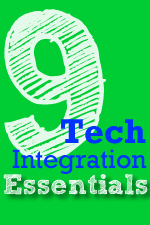Tech Integration: Nine Essentials
By Pamela Albert Devine Communicator October 2013, Volume 37, Issue 2 When I became the supervisor of curriculum and instruction at Point Road School in 1998, I began to align the use of technology with our curricula. However, I wasn’t able to affect true sustained change in how technology was used until I became principal in 2005.
By Pamela Albert Devine
Communicator
October 2013, Volume 37, Issue 2
 When I became the supervisor of curriculum and instruction at Point Road School in 1998, I began to align the use of technology with our curricula. However, I wasn’t able to affect true sustained change in how technology was used until I became principal in 2005.
When I became the supervisor of curriculum and instruction at Point Road School in 1998, I began to align the use of technology with our curricula. However, I wasn’t able to affect true sustained change in how technology was used until I became principal in 2005.
Since then, Point Road, a Pre-K-4 school, has embraced a focused movement in which the staff work collaboratively toward a common goal of preparing students to be high performers in the 21st century. Our efforts in technology have contributed in multiple ways to improved teaching, and a higher level of student engagement, and subsequent learning and achievement.
Here are the nine essential components of technology integration, based on our school’s journey.
High expectations. We focus on what we can do to help students be technologically prepared citizens. We ask: “In what ways is technology used that directly or indirectly communicates high expectations for all students?”
Administrative and budgetary support. In these difficult economic times, technology has remained a high priority for our district. We also rely on grant and corporate support, donations from our educational foundation, and free resources.
Ongoing, sustained professional development for teachers. Unless a district is committed to embedded professional development, teachers will not have high expectations for their students in the area of technology because their own skill set and confidence will be lacking.
Collaboration and co-teaching. The classroom teacher is responsible for determining how technology can support curricular work, and then through collaboration the technology teacher and the classroom teacher design projects.
Problem-based learning. Our approach to problem-based learning encourages students to explore real-world problems and challenges, developing cross-curricular skills in a collaborative setting.
Student-directed learning. This type of learning requires students to be “active, engaged” learners. Students’ interests, needs, and abilities determine what and how curriculum is taught in the classroom.
Teachers as facilitators. In order for technology integration to be successful, the teacher-centered environment of “transmitting knowledge” needs to shift to a student-centered learning environment where discovery and inquiry are key strategies for learning. Facilitators create an environment where students acquire knowledge by doing activities themselves.
Integration of technology, embedded in the curriculum at all grade levels and in all content areas. Technology integration requires students to access, evaluate, interpret, and apply information from print and non-print materials. Technology has become an effective tool in all aspects of student learning and in all content areas.
Alignment of instruction and authentic assessments. Authentic assessments are those in which students are asked to perform real-world tasks that demonstrate meaningful application of essential knowledge and skills. In order for assessment to be “authentic,” it must be aligned to the curriculum.
As you implement these nine technology integration components, keep these tips in mind:
- Let students discover things on their own. Always give them a teaser to get them started, but then let them go. Students are more creative and inquisitive than we sometimes give them credit for.
- Make sure teachers are involved in brainstorming. They know what they are doing in the classroom, and the more that technology can support the curriculum, the more it will be used.
- Work as a collaborative team. The principal, teachers, students, and parents all need to be active participants. All stakeholders have to be committed to the thoughtful and planned use of present and emerging technologies.
- Be a model. Embrace and use technology yourself. Be on the cutting edge, and share your enthusiasm.
Pamela Albert Devine is principal of Point Road School in Little Silver, New Jersey.
Adapted from A Technology Enabled Journey, Principal, January/February 2012.
—
Copyright © 2013. National Association of Elementary School Principals. No part of the articles in NAESP magazines, newsletters, or website may be reproduced in any medium without the permission of the National Association of Elementary School Principals. For more information, view NAESP’s reprint policy

